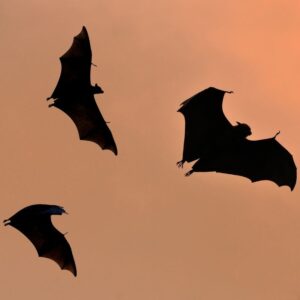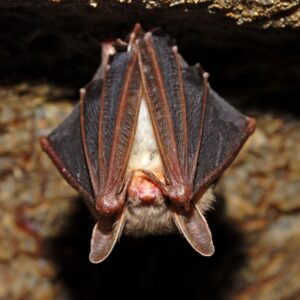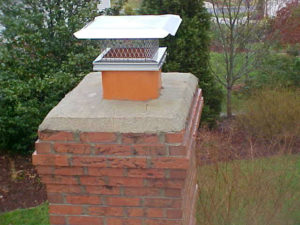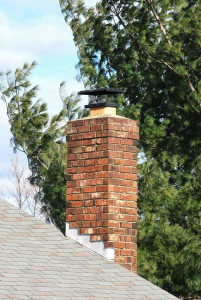URGENT!
Due to the weather, we are experiencing intermittent power outage and loss of internet. Please expect delays and or rescheduling of appointments during this time. We will reach out to you as soon as we can. Stay warm and stay safe!
If you thought the only things that make scary noises in the night were ghosts and goblins, think again. Sometimes, it’s the unexpected guests in your chimney that can send shivers down your spine.
Bats, while fascinating creatures, make for terrible roommates. So, why on earth would bats even choose this eerie abode? And, more importantly, what do you do if they decide to make your chimney their new haunt?
In Texas, as in many other places, bats are a protected species. According to the Texas parks and wildlife code, it is illegal to kill any species of bat without a permit unless it is an imminent threat to human health and safety.
In fact, the City of Houston strongly discourages do-it-yourself techniques to bat removal because of the dangers to both the bats and the humans handling them. Here are some things you can do to kick these squatters to the curb without hurting anything more than their pride.
 Identify the Species: Before taking any action, determine the species of bats residing in your chimney. The laws of what can and can’t be done to a bat can be different depending on the species of bat. Knowing what kind of bat is living in your chimney is a good start to getting them out of your home.
Identify the Species: Before taking any action, determine the species of bats residing in your chimney. The laws of what can and can’t be done to a bat can be different depending on the species of bat. Knowing what kind of bat is living in your chimney is a good start to getting them out of your home.Once the bats are gone there are some important things that you need to do to make sure they don’t come back and to make sure you can continue to use your chimney safely. Here are some steps:
✔️ Clean Up Responsibly
Just because the bats have left doesn’t mean that they didn’t leave things behind. Especially their guano. Guano is bat feces and it can be laced with disease. It is crucial that your chimney is cleaned thoroughly even if you don’t plan on using your chimney for a while.
✔️ Prevent Reentry
Just because they have left for now doesn’t mean that they won’t come back. Another bat colony will probably find your chimney just as appealing as the first colony did. Fortunately, there are things that can be done to prevent this:
 Bats love to roost in caves and trees. That is because they are dark, sheltered from the elements, and protected from predators. In fact, you can find bats in lots of human-made structures that provide these environments, such as home attics, under bridges, in tall building crevices, and, of course, we can’t forget the bats in the belfry at your local church. Your chimney meets all the appropriate criteria for a bat haven.
Bats love to roost in caves and trees. That is because they are dark, sheltered from the elements, and protected from predators. In fact, you can find bats in lots of human-made structures that provide these environments, such as home attics, under bridges, in tall building crevices, and, of course, we can’t forget the bats in the belfry at your local church. Your chimney meets all the appropriate criteria for a bat haven.
Just remember: Bats provide a huge advantage to the environment as they keep insect populations under control so it is important that when we evict them from our chimney that we do it humanely.
You don’t have to live with unwanted guests in your chimney. At Lords Chimney we can help you make sure your chimney is working as it should while keeping out unwanted guests. Call us today to schedule an inspection and keep those critters away.
Sick of birds setting up camp in your flue? Are squirrels and other critters scrambling throughout your chimney? Stressed about water-related masonry damages this fall? An easy way to resolve all of these worries is to invest in a high-quality, sturdy chimney cap and to have our team of professionals install it for you.
masonry damages this fall? An easy way to resolve all of these worries is to invest in a high-quality, sturdy chimney cap and to have our team of professionals install it for you.
Not sure where your current cap stands or whether or not it’s actually being effective? We’re here to help. Learn more about chimney cap basics below, then reach out to our crew with any questions. We’re always eager to lend a hand and keep our customers safer, more knowledgeable, and completely prepared for it all.
Now, not all caps are created equal, and the type of cap you’ll need will depend on the type of fireplace you have. If things aren’t matched up appropriately, you’ll end up with a lot of issues, and you’ll invite all kinds of hazards and dangers into your home. Fortunately, we know all there is to know when it comes to fitting the best cap for your system, so you’ll be in good hands when you hire our crew for the job!
The biggest thing to remember is that, no matter what type of chimney or fireplace you’re using, a cap is always a must-have component. Without one in place, those birds and woodland creatures will have easy access to your home, and you’ll find yourself with excessive water damage and debris build-up, too.
If a bad storm blew your cap off or if yours seems damaged or misplaced, please don’t hesitate to call us in. We would be happy to look things over and see where you stand, then suggest further services that are best suited to your needs.
If you have water coming into your home, or if you’re experiencing clogs, then that’s a clear indicator that your cap may need some adjustments. Other common problems we see are issues with the screening. Every chimney needs the right amount of screening, as well as the right type of screening, and without it, your chimney won’t be able to perform properly.
Usually these problems occur when chimney experts are not the ones hired to handle the task of keeping pests out of the chimney. Now, pest control professionals definitely know how to keep pests out of the home, but when it comes to chimneys they often get it wrong.
Essentially, if your screen is prone to experience build-up or if it lays flat, you’ll end up with issues. In both of these cases, nesting materials will block air, and you’ll have smoke backing into your home before you know it.
And while roofers offer some effective temporary fixes, most won’t do much for you long-term. We’ve even seen some take off the right cap and replace it with something less effective! Not good. In the end, hiring a CSIA certified pro is always the best route to take.
Now, as long as homeowners have some type of cap (whether that be single-flue, an umbrella type, or something else), we’re happy. That being said, you may find yourself replacing the less expensive, simpler models more often, and they aren’t always as effective as covering all of your bases (i.e. preventing animal entry, blocking out debris, stopping water damage, etc.).
The best route is always going to be investing in a full-coverage cap that keeps anything and everything that’s harmful away from your structure. It’s best for the design of the chimney, and it will save you money over time, both on repair/replacement costs and on damages that could occur throughout the system.
Now, one of the animals we worry most about in terms of your chimney is the chimney swift. These small birds may seem like nothing to stress about (especially compared to raccoons, bats, and other bigger critters), but the truth is that removing them isn’t as simple as you might think.
You see, chimney swifts are protected under the Migratory Bird Treaty Act, so once they establish themselves in your chimney, we can’t legally remove them. They’ll have to stay put until they leave on their own, after which we can remove their nests, so you aren’t left with any fire hazards.
And don’t think you’re off the hook once they’re gone! Once they’re done migrating, they’ll want to come right back to the same place they left, so preventing their entry is essential. That’s where an effective cap comes into play. Let us ensure you’re set up right, so you don’t have to deal with the hassle.
You won’t find a team in the Houston area that is more knowledgeable than ours. We have the experience, training, and expertise to ensure all of your chimney-related needs are addressed before your holiday season really takes off. We’d be happy to help you out soon, so please reach out now!
Animals love chimneys; whether it is raccoons or squirrels, roof rats or birds, many different types of animals view chimneys as a safe, protected space to nest, have their young, or hide from predators. Unfortunately, animal entry can cause serious damage to your chimney, as well as put you and your family at risk.
When an animal gets into your chimney, it can be harmful to them and damaging to your chimney. However, it is possible to avoid animal entry with regular chimney maintenance and a good chimney cap.
 How animals get in
How animals get inThe most common cause of animal entry into chimneys is a missing or damaged chimney cap. The chimney cap sits at the top of the flue, covering and protecting the flue from animals and the elements. While the solid metal top of the chimney cap prevents water from getting in, the mesh or wire sides serve two purposes: letting smoke out and preventing animals from getting in.
If they chimney cap is damaged in any way, it may be easier for animals to get in. Small holes, dents, damaged mesh, or missing screws might seem too minor, but even these small issues can leave spaces for animal entry. Birds and small mammals often only need a few inches of space to wiggle through, while raccoons have been known to claw or bite weak areas of chimney caps to create larger holes.
Even a tiny animal can create a big problem in your chimney. Below are some of the ways that animals can damage your chimney.
The best way to keep animals out of your chimney is by having a quality, well-fitted and correctly installed chimney cap. A quality chimney cap protects the area of your chimney that is most susceptible to animal entry, as well as keeps water and debris from entering your chimney. Regular chimney inspections can also be used to spot damage to the chimney cap or other areas of the chimney before animals can get in.
At Lords Chimney, we are the animal removal experts; not only can we safely get the animals out, but we can also prevent them from coming back with a quality chimney cap. Contact us today to learn more about how the chimney cap protects your fireplace system from animal entry.
Whether it’s a musty or moldy smell, a soft drip-drip sound coming from the chimney, or a puddle of water at the bottom of the firebox, a leaky chimney is a problem that cannot be ignored. Left unrepaired, even minor chimney leaks can create major damage throughout your fireplace system.
Thankfully, leaky chimneys don’t have to be a chronic problem. Identifying the source of the water entry and fixing your leaky chimney as soon as possible can prevent serious water damage to your fireplace system or home.
Chimneys are built to stand strong against the elements; however, there are still a number of points where water can work its way into the chimney system. The following are some of the most common causes of chimney leaks.
Chimney cap: The chimney cap protects the top of the chimney and keeps moisture, animals, and debris from falling into the chimney. A damaged chimney cap can allow water into the flue, causing damage throughout the fireplace and chimney structure.
Chimney crown: Often confused with the chimney cap, the chimney crown is a mortar slab that seals the top of the chimney. Chimney crowns should have small overhangs as well as be built with slightly sloped edges to prevent water from pooling on the top. Chimney crowns can deteriorate over time due to prolonged exposure to the elements; this creates cracks that allow moisture into the chimney.
Flashing: Flashing is the watertight metal strips that seals the joint between the chimney and the roof. Over time, flashing can lose its seal due to overexposure to the elements; flashing can also be damaged by storms or animals.
Masonry damage: Without regular maintenance, bricks and mortar can begin to deteriorate over time. The freeze thaw process – which causes water in bricks to freeze and expand – is the most common cause of water damage to masonry.
When it comes to fixing a leaky chimney, the most important step is to find and repair the cause of the chimney leak. Repairing the water damage without first removing the cause of the chimney leak will only lead to recurrent water problems. By uncovering the root cause of the chimney leak, you can rest assured that the water damage will not return once the necessary repairs have been made.
For chimneys with damaged masonry, tuckpointing may be used to repair or replace damaged bricks and mortar. During the tuckpointing process, small areas of damaged masonry are carefully removed before the new bricks and mortar are put in; this can help strengthen the chimney structure and help avoid the costs of rebuilding the entire chimney.
Another great way to prevent chimney leaks and water damage is by having your chimney waterproofed. Professionally waterproofing a chimney can seal and protect the masonry from water damage while still allowing the bricks to retain their semi-porous nature.
If you have a leaky chimney, trust the experts at Lords Chimney to repair it. Contact us today to schedule an appointment so we can help resolve your chimney leaks!
Your chimney and venting system consists of several different components to make it function safely and correctly. One of the most important parts of your chimney system, a chimney cap is needed to protect your chimney from water penetration, animal intrusion, and other things. While chimney caps are not required, we at Lords Chimney strongly recommend your chimney be capped for several essential reasons. As the cost and installation of a chimney cap is relatively inexpensive and can protect you against more expensive repair work, there is no excuse not to have a chimney cap on top of your chimney. We would like to tell you why a chimney cap is such a vitally important part of your chimney system.
According to EBSCO Research, a chimney cap keeps rain and melted snow from entering your chimney. If you receive a two-inch downpour of rain and have no chimney cap, you can get those two inches of rain water into your chimney. A chimney cap also protects you from wind issues. Persistent drafts can cause frustration and loss of money on heating bills. While a basic chimney cap will protect you from rain and melted snow, you can find special wind-resistant caps if you have problems with downdrafts in your chimney.
Even if you live in a climate with no snow and little rain, you still need a chimney cap to keep birds, squirrels, and raccoons out of your chimney. Many of these animals mistake chimneys for hollow trees and choose a chimney as a safe place to nest. Both the animals and their nesting can be fire hazards. The nests can cause chimney blockages and prevent toxic gases like carbon monoxide from exiting out through the chimney. This causes a risk of carbon monoxide poisoning since the gas is forced back into your home. Additionally, animals can become trapped and possibly die within your chimney, which causes a horrific odor and a possible bug infestation. To prevent these problems that come along with animal invasions. Contact Lords Chimney to install a chimney cap with metal screening on the sides to keep the animals out.
We have talked about how a chimney cap is needed to keep things out of your chimney, but a cap is also important to keep hot sparks and embers inside your chimney. Occasionally, sparks and embers can fly out of your chimney and land on your roof or your neighbor’s roof, which can possibly cause a house fire. These sparks and embers may also land in your yard on a pile of leaves or a bush and cause a brush fire, which can quickly and easily become out of control. To prevent this, have a chimney cap with spark arrestors, or wire meshing, to keep the hot sparks and embers safely within your chimney.
Have more questions about chimney caps? Contact Lords Chimney to talk to our expert staff about custom installing a chimney cap on top of your chimney.